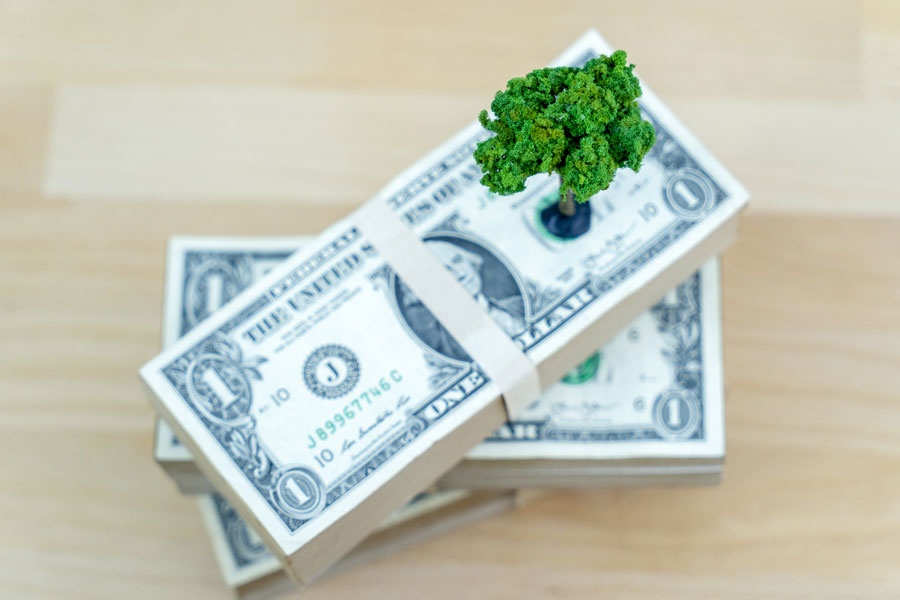

It would be difficult to miss the surging popularity of ESG investing, especially if you’re a financial journalist fielding press releases during the week of the 51st annual Earth Day celebration.
But beyond the pitches for interviews with executives and politicians who are saving the planet by growing their own tomatoes and supporting laws that make polluting more illegal than it already is, there is the investing angle.
Allowing for the environmental, social and governance nomenclature corn maze that detours toward sustainable, responsible, impact and things baked by grandma, it is obvious the general category is growing like organic mushrooms on the dark side of a decaying log in the woods of Maine.
According to Morningstar, money flowing into U.S. funds categorized as sustainable hit a record $51.1 billion last year, which is more than double the 2019 record of $21.4 billion.
For perspective, the annual flows into sustainable funds had been hovering around $5 billion for six straight years through 2018, and sustainable funds had annual net outflows in 2011 and 2012.
What happened over the past year is anyone’s guess, but most are guessing it has something to do with Joe Biden winning the Presidency and the anticipation of rolling waves of Green New Deals galore.
And everything seemed grand until earlier this year when something else happened that is also the result of anyone’s guess.
A simple screen of the 10 best-performing ESG funds over the 12-month period through March produced a stunning list of triple-digit performers.
From a 151% gain by the iShares Global Clean Energy ETF (ICLN) to a 267% gain by the Invesco Wilderhill Clean Energy ETF (PBW), it seemed as if the riddle of investing had been solved and that the marriage of Wall Street and ESG had been fully consummated.
A closer look, however, exposed that other thing that happened. Starting around February, while most of the rest of the financial markets were doing pretty much what they’ve been doing for more than a decade, the ESG category started to quietly and almost uniformly decline.
Those same 10 funds that topped the Morningstar list of high performers started to unravel in February, leading to first-quarter returns ranging from a loss of 14.4% by the iShares Clean Energy ETF to a gain of 5.3% by the SPDR Kensho Clean Power ETF (CNRG).
This was all happening while the S&P 500 Index was chugging along with a 12-month return through March of 36.4%, including a gain of 7.4% during the first three months of this year.
When pressed to dissect the sudden turnaround for ESG funds, Jon Hale, Morningstar’s head of sustainable investing research, shrugged it off as simple profit-taking and other boring stuff.
“It’s not surprising to see these funds taking a breather after triple-digit gains last year,” he said. “Investors are enthusiastic about putting capital behind renewable energy companies, but they have bid up valuations, and we may see a modest correction. I doubt this is a boom-bust cycle, though, given the growing momentum towards decarbonizing the economy, including increased support from policymakers.”
Todd Rosenbluth, director of mutual fund and ETF research at CFRA, also downplayed the abrupt collapse of the ESG category as less significant in the context of the longer-term potential.
“I don’t have insight into the stocks that have fallen off, but a more value-oriented stock market and profit taking played a role,” he said. “However, the long-term prospects for clean energy ETFs remains strong.”
Jordan Waldrep, president and chief investment officer at TrueMark Investments, is a little closer to the action with a brand new ESG Active Opportunities ETF (ECOZ) that gained 46% during the 12 months through March, including a first-quarter gain of 5.6%.
Waldrep jokes about the timing of his fund’s March 2, 2020, launch just as the stock market was falling in response to the emerging Covid pandemic, but he also recognizes the drive the followed.
“There was a momentum trade off the idea that the new administration would be moving a ton of money into green infrastructure, but the reality is those things were already in play,” he said. “The reason it’s so exhilarating to drive a Tesla is because it’s the fastest car you’ll ever drive, and people are excited about wind energy because it’s cheap.”
Waldrep is a big-picture kind of guy who talks with informed fluidity about ESG as the “third industrial revolution,” but he’s also a portfolio manager and he can spot an overly enthusiastic situation.
“Things are as good as they can get and they had gotten expensive, at least on a near-term basis,” he said. “We’re experiencing a generational type thing and how it plays out is not yet clear. But as it plays out these names will become more stable and more a part of our lives.”
Therein lies the blending of the old and the new to create the now. ESG in its myriad forms has been around for eons, but it’s the newer technologies and evolving perspectives that make it new and innovative.
That’s what the markets are absorbing and doing it in the only way markets can. In other words, don’t be too hoodwinked by the outsized performance, and don’t be too jarred by the sudden pullbacks.

Relationships are key to our business but advisors are often slow to engage in specific activities designed to foster them.

Whichever path you go down, act now while you're still in control.

Pro-bitcoin professionals, however, say the cryptocurrency has ushered in change.

“LPL has evolved significantly over the last decade and still wants to scale up,” says one industry executive.

Survey findings from the Nationwide Retirement Institute offers pearls of planning wisdom from 60- to 65-year-olds, as well as insights into concerns.
Streamline your outreach with Aidentified's AI-driven solutions
This season’s market volatility: Positioning for rate relief, income growth and the AI rebound
